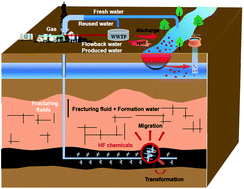Towards improved characterization of the fate and impact of hydraulic fracturing chemicals to better secure regional water quality
Abstract
Hydraulic fracturing (HF) of shale and other permeable rock formations to extract gas and oil is a water-intensive process that returns a significant amount of flowback and produced water (FPW). Due to the complex chemical composition of HF fluids and FPW, this process has led to public concern on the impacts of FPW disposal, spillage and spreading to regional freshwater resources, in particular to shallow groundwater aquifers. To address this, a better understanding of the chemical composition of HF fluid and FPW is needed, as well as the environmental fate properties of the chemical constituents, such as their persistence, mobility and toxicity (PMT) properties. Such research would support risk-based management strategies for the protection of regional water quality, including both the phase-out of problematic chemicals and better hydraulic safeguards against FPW contamination. This article presents recent strategies to advance the assessment and analysis of HF and FPW associated organic chemicals.

- This article is part of the themed collection: Contaminant remediation and fate


 Please wait while we load your content...
Please wait while we load your content...